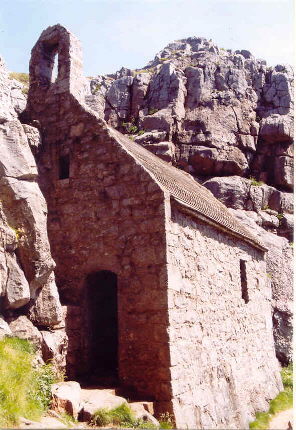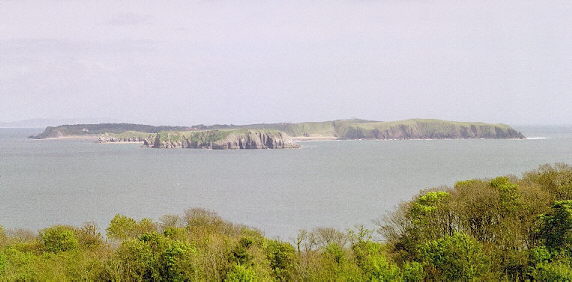By
Karen Pereczes
As appeared in Country Walking magazine. Copyright Karen Pereczes 2005.

A life lived in fear is a life half-lived I tell myself, as I nervously approach the 'man over cliff' warning sign. I peek over the precipice at the sea below, waves crashing onto jagged boulders, and inhale the air and saltwater spray. The terrain is wild, dangerous... and breathtakingly beautiful.
I'm walking the
south Pembrokeshire Coast Path with Country Walking's Nicola and my
14-month-old daughter, Eocha. And
today we're in search of Pembrokeshire's pirates. Ahead of us is Stack
Rocks and we pause for a fantastic aerobatic display, guillemots performing
freefalling spirals in the spray. Stack Rocks is also known as Elegug Stacks; Elegug being the Welsh word for guillemot. Two huge pillars of
detached limestone are home to large colonies of these classic seabirds, as well
as fulmar petrels, razorbills and many gulls.
To our west is a
stretch of coastline that to this day still suffers at the hands of warmongering
seafarers, though those of a more modern variety...
the coastline is permanently closed due to unexploded missiles. But a
notice ahead tells us that the path to the east is open - there is no firing at
Castlemartin military range today.
In the distance is the 'Green Bridge of Wales' - a magnificent natural limestone
arch, and immediately east is Flimston Castle; an Iron Age fort with stone banks
enclosing the Cauldron - a massive blowhole 150 feet deep. Below are caves and a
natural harbour. Whoever sailed from here would need to have been highly skilled
to negotiate the 25-foot rise and fall of the tide and the powerful current.
Clinging to the cliffs
of the secluded headland is a 6th century Celtic hermitage, founded
when St. Govan hid in a rocky fissure to escape from Pembrokeshire's pirates
and, thankful for his life, built a chapel on that very spot. Nobody knows St.
Govan's true identity. Some say he was Sir Gawain, King Arthur's nephew and
a Knight of the Round Table, while others say he was an Irish abbot, St. Gobham.

I attempt to count the
steep, uneven steps underfoot that legend says number differently down and up -
and tally 72 as I descend. No doubt the number will change on my return. St.
Govan's Head is the southernmost point of Pembrokeshire - on a clear day
offering views of Devon and Cornwall, the Gower Peninsula and Lundy Island.
Below is New Quay, an old harbour and favourite pirate landing spot. A cargo of
spirits smuggled from here in 1833 was carried off in bags on horseback and
distributed locally - reminding me of the film Whisky Galore. Are we getting
closer with our quest?
At Broad Haven beach,
with its spectacular 'Church Rock', I can't help looking to the horizon
and wondering how it must have felt to be out on the high seas during the Golden
Age of piracy, living in fear of pirates like Pembrokeshire-born Bartholomew
Roberts, aka 'Black Bart', one of the most successful and menacing pirates
of all time.
In his time Bart
captured 400 ships and collected £80 million of treasure. But he is better
remembered as the originator of the universal pirate emblem - the Skull and
Crossbones. Because he wore a red coat, the French called him 'Le Joli Rouge',
which was corrupted to Jolly Roger by the English and eventually became
associated with the flag, rather than the person.
A little further down
the coast and we reach the village of Manorbier. Gerald of Wales, a writer,
historian and ecclesiastic, who was born in Manorbier castle in 1146, described
this area as 'the pleasantest spot in Wales', and I have to agree with his
sentiment, if not his grammar. As I walk past the Neolithic cromlech known as 'King's Quoit' to Priest's Nose, it's easy to understand why this spot
has a long history as a sacred place. The landscape is powerful and dramatic and
exudes an energy that has inspired men and women throughout the ages, people
like Virginia Woolf, who wrote 'The Waves' during her time here.
Shortly after the
turquoise waters of Precipe Bay - whose hidden depths conceal the sunken wreck
of the Tormentor, a torpedo boat destroyer that sank in 1929 - the path goes
inland, taking a detour around the Royal Artillery Range that, sadly, prohibits
access to Old Castle Head - a fort dated at 300BC. Nicola, Eocha and I
continue to Skrinkle Haven, where fingers of Carboniferous Limestone and Old Red
Sandstone rock, with its natural arches known as the 'Church Doors', stretch
across golden sand to dip into the sea. Fulmars and razorbills nest on these
cliffs, while gulls noisily catch the breeze.
After the spectacular
vertical beds of limestone at Skomar, and its Iron Age fort, the path descends
steeply down a gorge to Lydstep Caverns. Here, a great blowhole called Draught
provided access to 'Smugglers Cave'. As it is low tide, we clamber down to
explore inside. The rock formations are a higgledy-piggledy mix of giant molar
teeth and tall reaching spires surrounding hollow caverns.
Looking out to sea
from Lydstep Point is Caldey Island, where Cistercian monks continue a tradition
of prayer and peaceful living that began in Celtic times. But the island has a
lesser known, more violent past... smugglers hid their booty in Cathedral Caves,
and Caldey was a refuge for Pembrokeshire's most notorious freebooter John
Paul Jones and his fantastically named lookout Leekie Porridge.

Jones, a ruthless
marauding pirate akin to the legendary Blackbeard, was born in Scotland and is
credited by some as being the founder of the US Navy. He regularly moored up at
Caldey to take on fresh water, anchoring in what is still known today as 'Paul
Jones Bay'. It is said that when
he died in 1792 his body was pushed into a crevice in the rocks near Ord Point.
Captain Henry Morgan,
whose name today is forever linked with bottles of rum, also hid out on Caldey
Island. Born around 1635 in Llanrumney, Monmouthshire, this Welshman sailed as a
privateer, though his behaviour was, at times, more like that of a mercenary. In
I67I, when returning from plundering the city of Panama, he left most of his
faithful followers behind, without ships or food, slipping off in the night with
most of the booty to Jamaica. Towards the end of his life, Henry Morgan is said
to have bought an estate in Jamaica, and the Welsh accent is credited as being
the origin of the Caribbean accent today.
Nowadays, fishing and
pleasure boats have taken the place of sloops and schooners - but, for me,
this part of Pembrokeshire, with its with its secret caves and coves, will
always be remembered as the Pirate Path.